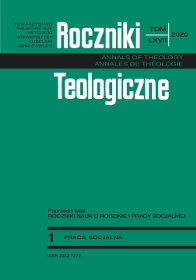Ukrainian Volunteers – New Generation of Social Workers. Problems and Perspectives
Abstract
The charity activity in warring Ukrainian society stipulated the interest to the social work volunteer’s problem. Substantial changes also happened in the world psychology and social work: positive health psychology and positive approach to social work appeared; “emotional revolution” proceeds in the field of professional labor, the positive functioning of personality and to his/her well-being. Such initiatives and orientation were the methodological basis of the conducted research.
The sample of the research included 100 Ukrainian paramilitary volunteers. The interconnections between, the one side, the level of the emotional burnout, “the Dark triad” personality traits and, the another side, subjective and psychological well-being have been examined.
It turned out that the greater part of the tested persons is “within the limits of the norm” of burnout, but only in the first and second phases of emotional burnout – “tension” and “exhaustion”. However the number of volunteers with high positive personality traits and low negative ones as “the Dark Triad” and vice versa low positive and high negative – in the third phase of emotional burnout – “resistance” in 1,5 times higher (64 / 42%) accordingly. Paradoxical reverse interconnection was also found out high indexes of “the Dark Triad” and low – emotional burnout, positive connection of narcissism with the level of subjective well-being. The only fact that distinguishes two groups of volunteers is the best indexes of psychological well-being and conscientious as personality trait (Big-Five).
These data testify to the greater vulnerability for the negative consequences of burnout of high moral, “good” volunteers (low “Dark Triad”).
The received results compel researchers to think: Does it really mean that “to be a best” paramilitary volunteer is not to have strong health but have significant level of emotional and occupational burnout in the conditions of war?
References
Boyko, V.V. The energy of emotions in communication: a look at oneself and on others. Yaroslavl: Avers Press, 2004.
Caprara, G.V. “Positive orientation: Turning potential into optimal functioning.” The European Health Psychologist (2009), 11: 46–48.
Definition of BURNOUT [https://www.merriam-webster.com/dictionary/burnout] (accessed 22 June, 2019).
Deiner, E. International differences in well-being. N.Y.: Oxford University Press, 2010.
Dierendonck, D.V., Schaufeli, W.B., Siksma, H.J. “Burnout among general practitioners: a perspective from equity theory,” Journal of Social and Clinical Psychology (1994), 13 (1): 96–108.
Ekimova, S.G. Volonterskaia deiatel’nost” kak resurs lichnostno-professional’nogo razvitiia budushchikh spetsialistov po sotsial’noi rabote,”. Diss. kand. ped. nauk. [Volunteering as a resource for personal-professional development of the future of social work. PhD (pedagogy) diss.]. Khabarovsk, 2010.
Emotions at work: Theory, research and applications for management. Ed. R.L. Payne, C.L. Cooper. Chichester, UK: John Wiley and Sons, 2006.
Hulsheger, U.R., Lang, J.W., Maier, G.W. “Emotional labor, strain, and performance: Testing reciprocal relationships in a longitudinal panel study.” Journal of Occupational Health Psychology (2010), 15(4): 505–521.
Freudenberger, H.J. “Staff Burnout.” Journal of Social Issue (1974), 30 (1):159-65.
Fullugar, C., Kelloway, E.K. “New Directions in Positive Psychology: Implications for a Healthy Workplace.” In: Contemporary occupational health psychology: Global perspectives on research and practice. Ed. J. Houdmont, S. Leka, R.R. Sinclair (146–161). Chichester, UK: John Wiley & Sons, Ltd., 2012.
Jones, D.N., Paulus, D.L. “Introducing the Short Dark Triad (SDT): A Brief Measure of Dark Personality Traits.” Assessment (2014), 21(1): 28–41.
Korneeva, E.L. The main directions of research volunteer activities [Elektronnyi resurs]. Psikhologicheskaya nauka i obrazovanie PSYEDU.ru [Psychological Science and Education PSYEDU.ru], 2015, vol. 7, no. 1. Available at: http://psyedu.ru/journal/2015/n1/Korneeva.phtml (Accessed dd.mm.yyyy). (In Russ., Abstr. in Engl.).
Maslach, C. Burnout: The cost of caring. NY: Prentice-Hall, 1982.
Maslach, C., Leiter, M.P. “Understanding the burnout experience: Recent research and its implications for psychiatry.” World Psychiatry (2016), 15(2): 103-111.
Nosenko, E.L., Hrysenko, N.V. “Novyi pidhid do doslidjennya ‘tsinnostey u diyi: perevahy, dosvid, zastosuvannya dlya vyvchennya chynnykiv emotsiynoho vihorannya pedahoha,” Zbirnyk naukovykh prats KPNU imeni Ivana Ohiyenka. Problemy suchasnoyi psykhologiyi (2010), 10: 490–500.
Pines, A.M., Aronson, E., Kafry, D. Burnout. From Tedium to Personal Growth (345–356). NY: Free Press, 1981.
Paulhus, D.L., Williams, K.M. “The Dark Triad of personality: Narcissism, Machiavellianism and psychopath.” Journal of Research in Personality (2002), 36(6): 556–563.
Rawlins, T.D., Houska, А. “Motivations and satisfactions of the hospice of wichita volunteer: implications for marketing.” American Journal of Hospice and Palliative Care (1986), 3(4): 15–18.
Ryff, C. “The Structure of Psychological Well-Being Revisited.” Journal of Personality and Social Psychology (1995), 69(4): 719–727.
Seligman, M.E.P., Steen, T., Park, A.N., “Positive Psychology Progress. Empirical Validation of Interventions,” American Psychologist (2005), 2: 410–421.
Selye, H., Stress without distress. Moscow: Progress, 1998.
Seibert, L.A., Miller, J.D., Few, L.R., Zeichner, A., Lynam, D.R. “An Examination of the structure of self-report psychopathy measures and their relations with general traits and externalizing behaviors.” Personality Disorders: Theory, Research, and Treatment (2011), 2(3): 193–208.
Vodopyanova, N., Starchenkova, Y. Burnout syndrome: diagnosis and prevention. 2nd ed. SPb.: Peter, 2008.
Copyright (c) 2020 Roczniki Teologiczne

This work is licensed under a Creative Commons Attribution-NonCommercial-NoDerivatives 4.0 International License.





